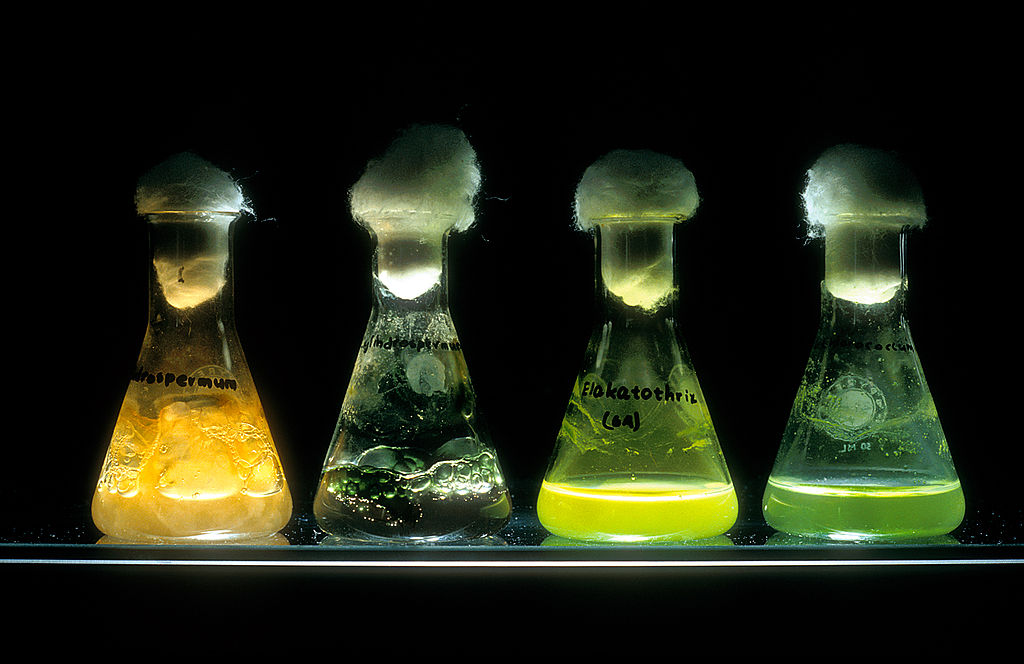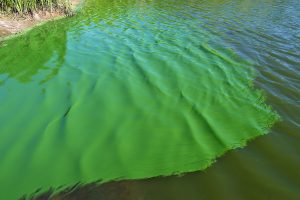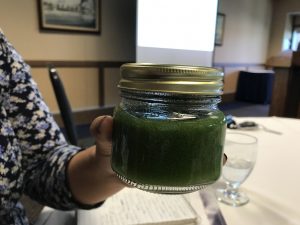
“The whole pattern of the fishery is changing”
As greatlakesnow.org has been reporting, a portion of the Maumee River that flows through Downtown Toledo has been placed under a recreational advisory by the Toledo-Lucas County Health Department because of a strong algal bloom. Health officials say city tap water remains safe.

Bloom of cyanobacteria in a freshwater pond, courtesy of Christian Fischer
But people who depend on Lake Erie’s waterways and fisheries are sounding alarms.
And some people who live near the algal bloom say they’ve never seen it such a strong green color.
The health department is advising people to avoid contact with the Maumee River from the Anthony Wayne Bridge to the river’s mouth. Children, pregnant and nursing women and people with compromised health are advised against swimming or wading in the river.
To get a better understanding of Lake Erie’s algae blooms, I recently visited Maumee Bay State Park in Oregon, Ohio. The shoreline was posted off limits to swimming. The bright algae was almost neon green in color, and whipped up into green suds when motor boats sliced through it.
The bright green color is caused by microcystin, a potentially lethal toxin.
On a boat tour of Maumee Bay, I interviewed Captain Paul Pacholski, President of the Lake Erie Charter boat association.

Microcystis Algae from Maumee Bay, courtesy of Mary Ellen Geist
He said, “It’s my understanding that not even the Asian Carp will eat this cyanobacteria. Even though it’s an algae of sorts, it’s half-algae, half-bacteria. And because it’s a bacteria, it’s able to set its own buoyancy and dominate the ecosystem that it’s in. Because it can float up to the surface and when it gets very thick, it will limit the amount of exposure to the sun of beneficial algae, and when that happens, the zooplankton that feeds on the beneficial algae start starving.”
“The whole pattern of the fishery is changing,” says Pacholski. “At this point – I’ve been doing this for 35 years – we used to be able to catch walleyes just about anywhere you wanted any time of the year according to abundance. Now it seems that a lot of the fish are changing their patterns. They’re moving east earlier and staying longer – east being the central basin where the water is clearer and less dominated by the microcystis. “
Pacholski says if action is not taken, “You’re going to see what happened in the 60’s and 70’s when Lake Erie got the reputation of being a dead lake. We’ve been trying to outlive the reputation of what happened along the Cuyahoga. People now are reliving those memories.”
See the full interview here:
Health Department officials are advising people to rinse their skin immediately if they come in contact with water associated with the algal bloom along the Maumee River and to seek medical attention if there are signs of exposure. However, the health department says fishing and eating fish out of the river is not a threat to human health.
Excessive algal growth in Lake Erie poses significant threats to the ecosystem and human health of a body of water that provides drinking water for 12 million people in the U.S. and Canada. It also threatens a 12.9 billion dollar tourism industry and fishery. The U.S.-Canada binational Great Lakes Water Quality Agreement calls for significant reductions from the Maumee River and other sources of the western and central portions of the basin. The U.S. has committed to reduce these sources by 40 percent from the 2008 baseline – that’s about 7.3 million pounds.
The U.S. EPA is collaborating with federal and state partners in developing domestic action plans.
The U.S. Action Plan is available for public comment through September 29th and can be accessed here: epa.gov/glwqa
For more information about the harmful algal blooms in Lake Erie, go to glerl.noaa.gov




